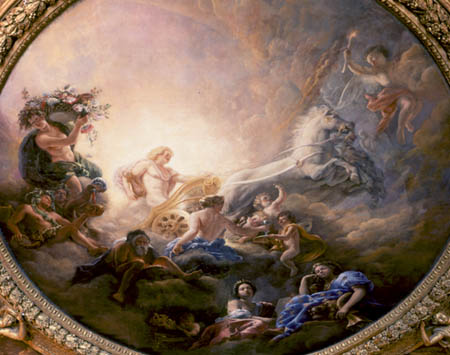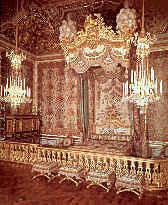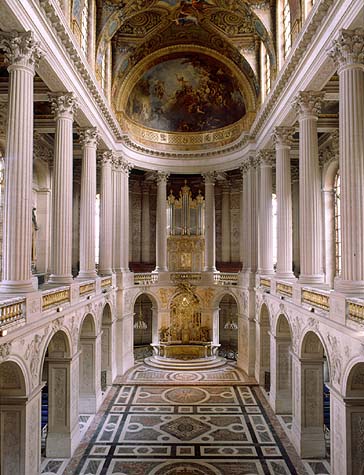Chateau de Versailles
Construction
The Old Chateau

Back in 1623, Louis XIII - father of Louis XIV - built a 'hunting lodge, a little gentleman's chateau' of brick, stone, and slate at Versailles. The king liked it so much that he soon had it enlarged by his 'royal engineer and architect', Philibert Le Roy (this early chateau survives in the buildings that flank the Marble Courtyard). Then from 1661 to 1668 the young Louis XIV, known as the Sun King, had his own architect, Louis Le Vau, embellish the residence. Yet this little house of cards', as the memorialist Duc de Saint-Simon called it, remained too small. Extensions were deemed necessary.
The New Chateau

Le Vau was once again charged with carrying out the work. From 1668 to 1670 he built the 'envelope', which Saint-Simon severely criticized for contrasting with the old chateau: 'the beautiful and the ugly, the vast and the restricted, were stitched together'. Indeed, Le Vau's 'envelope' entailed wrapping the old chateau in a second building whose uniformly white stone facades served as a fine garden setting. Work on this building, whose central terrace was inspired by Italian baroque villas, was taken up by Francois d'Orbay on Le Vau's death in 1670. It houses the State Apartments.
Official Residence

In May 6, 1682, Versailles became the official residence of the Court of France, supplanting the palaces at the Louvre and Saint-Germain-en-Laye. From 1678 to 1684, meanwhile, the terrace of the new chateau was transformed into the Hall of Mirrors, symbolizing the power of the absolute monarch. Feverish building activity then gave birth to the North and South Wings, the Orangery, Stables, and Grand Lodgings; the vast construction site was headed by royal architect Jules Hardouin-Mansart. The last major feature built during the reign of Louis XIV, the Chapel Royal, was completed in 1710 by Robert de Cotte.
The Grand Reconstruction Project
Toward the end of the reign of Louis XV, around 1770, Jacques-Ange Gabriel built the Opera and began reworking all the facades on the chateau's town side. Only the right wing, which threatened to crumble, was executed. It strictly obeyed the rules of French classical architecture, as seen in its colonnaded pavilion. Inside, the grand staircase known as Grand Degre was begun in 1772, but only recently completed in 1985. A symmetrical pavilion on the other side of the courtyard, planned by Napoleon Ier, was finally erected in 1820.
State Apartments (Grand Apartments) and Hall of Mirrors
The Grand Apartment (Grand Appartement du Roi)

'And since the Sun is the emblem of the King, seven planets were taken to serve as the subject of the paintings of the seven salons of this apartment' (Felibien des Avaux, 1674). The Grand Apartment glorified the Sun King. A room known as the Abundance Salon led to other salons_Venus, Diana, Mars, Mercury, and Apollo_each dedicated to a heavenly body. That is why they were originally called the Apartment of the Planets when the New Chateau was being built. In 1710, another salon was added, this time dedicated to the mythological hero Hercules. It was designed to house Veronese's Christ at Supper with Simon, which the Republic of Venice offered to Louis XIV in 1664 (restored in 1997). The Hercules Salon is richly decorated in marble and chased bronze over the fireplace (the finest in the chateau), making it a rival to the Hall of Mirrors. The masterful painting on the ceiling, done by Francois Lemoyne from 1733 to 1736, shows The Apotheosis of Hercules.
Charles Le Brun, Premier Peintre

'All the arts work under him'. As Premier Peintre, or Chief Painter to the King, Charles Le Brun (1619-1690) directed the team of artists who decorated the ceilings at Versailles. All were members of the Royal Academy of Painting and Sculpture, which Le Brun vigorously headed. As a versatile decorative artist who also ran the crafts manufactory at Les Gobelins, Le Brun was able to design the entire decoration of a room, down to the details on a door-lock
The Hall of Mirrors (La Galerie des Glaces)
The Hall of Mirrors, erected to the glory of Louis XIV and now the chief masterpiece of Versailles, was begun in 1678 when the chateau became the official residence, disrupting the order of the salons known as the Apartment of the Planets. On the signing of the Treaty of Nijmegen, which represented the highpoint of his reign, Louis XIV ordered Le Brun to depict his government's accomplishments on the ceiling of the hall. Le Brun designed thirty compositions, framed by stucco-work, showing the monarch in various guises: Roman emperor, great administrator of the kingdom, and victor over foreign powers.
The Hall of Mirrors : Close-Up on a Masterpiece
The hall measures 73 metres long, 10.5 metres wide, and 12.3 metres high. At one end is the Salon of War, at the other is the Salon of Peace. Seventeen windows overlooking the garden are matched by seventeen arcaded mirrors along the wall. These exceptionally large mirrors were made in a Paris workshop founded by Colbert to compete with Venice's glass factories. The arches are set on marble pilasters whose gilded bronze capitals are decorated with the symbols of France_the fleur-de-lys and the Gallic cockerel_according to the new 'French order' of architecture invented by Le Brun. The finest ancient statues in Louis XIV's collection, as well as busts of Roman emperors, dot the walls. The solid silver tables, lamp holders, and orange-tree pots that originally adorned the gallery, however, were all unfortunately melted down by Louis XIV himself in order to finance his wars.
The Hall of Mirrors was not only the symbolic focus of the kingdom during the ancien regime, but also continued to play a key historical role after the Revolution. In 1919, the First World War officially ended when Germany signed the Treaty of Versailles in the Hall of Mirrors; Hungary signed the treaty the following year in the Grand Trianon.
The Queen's Suite (Grand Appartement de la Reine)
The king's 'Grand Apartment' was soon used only for state purposes, whereas the first ladies of France continued to live in the Queen's Suite. Maria Theresa, wife of Louis XIV, lived there until her early death in 1683, as did Maria Leszczinska, wife of Louis XV (who later modified the layout). Finally, Marie-Antoinette refurbished the decoration In the order dictated by royal protocol, the suite was arranged as follows: Queen's Guards Room, Antechamber, Peers' Salon, and Bedchamber. The paintings on the Italian-style ceilings, showing the virtues of queens of antiquity, mostly date from the reign of Louis XIV. The marble that originally lined the walls has largely been replaced by woodwork.

The Queen's Bedchamber
It still looks today as it did when Marie-Antoinette left Versailles during the French Revolution in 1789. The Rococo-style woodwork, as well as the ceiling painting by Francois Boucher (1703-1770) were commissioned around 1730 by Louis XV in order to please his wife, Maria Leszczinska. Marie-Antoinette found this terribly old-fashioned, and decided to replace all the furnishings, notably commissioning silk hangings woven in patterns of lilacs and peacock feathers, garnishing the alcove and the enormous four-poster bed (restored in 1976).
King's Bedchamber and Private Apartments
The King's Suite (Appartement du Roi)

The layout of royal apartments was dictated by the requirements of public and private life. As early as 1683, Louis XIV abandoned his Grand Apartment, henceforth open to all, in order to live in his own suite, known simply as the Appartement du Roi, which included the King's Guards Room, Antechamber for Grand Couvert repasts, Oeil-de-Boeuf Salon, King's Bedchamber, and Council Cabinet. The majestic painted ceilings and marble walls of the Grand Apartment gave way here to carved woodwork in white and gold, and plain ceilings. This lighter style reflected a new taste on the part of Louis XIV who wearied of allegories and henceforth wanted 'youthfulness strewn everywhere.'
The King's Bedchamber
Louis XIV's bedchamber occupied the exact centre of the chateau from 1701 onward. It was a key setting for events in the Sun King's day and was arranged to reflect this ceremonial function. A gilded wood baluster separated public space from private space; the alcove, where the bed is set, was a place reserved for the monarch alone. The decoration is particularly rich, comprised not only of gilded woodwork and heavy brocade embroidered in gold (restored in 1980), but also paintings by the finest artists. These paintings by Le Valentin, Van Dyck, Domenichino, and Lanfranco were chosen by the king himself and set into the wood panelling, indicating how the most valued pieces in the royal collection were integrated into the decor.
The Private Apartments (Le Petit Appartement)
After Louis XIV's Bedchamber and Council Cabinet come a string of smaller, more private rooms where Louis XIV kept his collections. Under Louis XV and Louis XVI, these rooms were modified into a small suite with a bedroom where the king slept, studies where he could work, and private dining rooms. Entirely redecorated in the eighteenth century, the ensemble now constitutes a period masterpiece of French woodwork and furnishings.
The King's and Queen's Cabinets
Still more intimate and private were the small 'cabinets' where the royals could unwind. Although a queen's inner cabinets at Versailles were always more restrained than the king's, they now provide touching testimony of the presence of Marie-Antoinette and boast a unique collection of precious furniture. The king's cabinets, meanwhile, were spread over several floors and were constantly adapted to royal pastimes_libraries, winter and summer dining rooms, geography gallery, cabinet where Louis XV tooled ivory and laboratories where he cooked, room where Louis XVI did ironwork, and so on. Louis XV also welcomed a select circle of 'friends' at post-hunt suppers where Madame de Pompadour sparkled. The king's next favourite, Madame du Barry, also had an apartment here.
Louis XV's Chocolate Recipe"Place one tablet of chocolate for each cup of water in a coffee pot and bring it slowly to the boil; when ready to serve, add one egg yolk for every four cups and stir with the baton over a slow fire, without boiling. It is better if made in the evening for the next day. Those who drink it every day save a leaven for the next day's pot. Instead of an egg yolk, a whipped egg white can be used after removing the first froth; blend it with a little chocolate taken from the coffee pot, then put it in the pot and finish off as with a yolk."
Chapel Royal - Opera
The Chapel Royal

The Chapel royal at Versailles is consecrated to Saint Louis (that is to say Louis IX of France, the French monarchy's crusader king). The chapel features a tribune on the same level as the royal apartments, overlooking the nave. That is where Louis XIV, Louis XV, and Louis XVI attended daily mass, an important moment in a king's day. They only descended to the center of the nave for major liturgical ceremonies. Normally, the nave was occupied by the courtiers, who remained standing while the ladies of the Court filled the lateral galleries. Members of the Chapel music, renowned throughout Europe, occupied the steps surrounding the organ.
The Chapel Royal: An Original Design
The chapel's architecture is simultaneously Gothic and Baroque. Its floor plan, loftiness (over 25 metres high), stained glass, pointed roof and gargoyles all hark back to medieval cathedrals. Its columns and balustrades, meanwhile, are typical of the early 1700s, as are the carved pillars, painted vaults, and coloured marble tiling. This bold compromise was the work of Jules Hardouin-Mansart, even though the chapel was not consecrated until 1710, two years after the architect's death.
The Chapel Royal: A Masterpiece of Sculpture

Hardouin-Mansart's brother-in-law, Robert de Cotte, oversaw the interior decoration. It is strikingly white, colour having been used only on the marble flooring and painted ceiling (typical of the colourist bent of the French school after Le Brun). The outstanding decorative feature is nevertheless the scope and quality of sculpture_the chapel constituted the largest sculpture worksite in the early eighteenth century. Every single inch of stone was delicately carved, developing an iconographic parallel between the Old and New Testaments, while the pillars are adorned with magnificent trophies of liturgical objects. The altar glitters with its gilded bronze bas-reliefs, featuring a Descent from the Cross at the base by Van Cleve and, at the top, the symbol of God.
The Opera : The Finest Court Theatre

The auditorium is entirely of wood, giving the opera house perfect acoustics. It was unusually large for a court theatre, since it could seat 712 people. Gold is harmoniously blended with the pinks and greens of the painted marbling and with the sky-blue curtain and upholstery. Breaking with traditional Italian-style theatres which stacked tiered boxes like 'chicken coops', two balconies ring the house, topped by an ample colonnade that seems to extend into infinity thanks to a play of mirrors.
The Opera: From Louis XV to the Present
It was only at the very end of Louis XV's reign in 1770 that Ange-Jacques Gabriel built a large hall for spectacles at Versailles. The spur was the marriage of the Dauphin (the future Louis XVI) to Marie-Antoinette - a large hall was needed for the wedding banquet and for the balls on the following days. The opera, then, is a convertible hall, endowed with an ingenious mechanical system that raised the floor of the auditorium level with that of the stage. It was so expensive to use the hall (10,000 candles were consumed in a single evening!) that it was employed for only a few festivities.
Museum of French History
'To All of France's Glories'
Versailles' history galleries constitute the largest history museum in the world (18,000 square metres), its contents being composed of masterpieces. The history of France is told through painted and sculpted imagery. Founded in 1837 by King Louis-Philippe, the museum was dedicated to 'all of France's glories'. Therefore only victories are depicted, not defeats...
Enormous Commission, Vast Works

Louis-Philippe commissioned 3,000 paintings from all the artists of the day, including Eugene Delacroix. These new works were designed to complement older ones (from the Middle Ages to the 1830s) and thereby form complete historical sequences. The multitude and quality of depictions of famous figures make Versailles an outstanding portrait museum. Vast construction work was required to transform the apartments into museum galleries so that the works could be hung.
Today's Museum: A Twin Role

Since the early twentieth century, curators have concentrated on the restoration of the original decor of the central core of the chateau (State Apartments and Private Apartments as well as the apartments of the Dauphin, Dauphine and royal princesses on the ground floor). The lateral wings, meanwhile, still house the museum founded by Louis-Philippe. To the north are the galleries devoted to the Crusades, the seventeenth and nineteenth centuries, while the south wing features the Revolution, the Consulate and Empire periods, and the Battle Gallery. This ensemble is completed by the Jeu de Paume Court and the Coach Museum, both located in the town of Versailles itself. The eighteenth-century collections, finally, are distributed throughout the apartments.
The Battle Gallery

The Battle Gallery is included in the Chateau's grand circuit. At 120 metres, this is the longest hall in the Chateau. It recounts French history through masterpieces. From the founding of the monarchy by Clovis to the wars of Emperor Napoleon I, all of France's great battles are depicted in a cycle of monumental paintings.
Great Parliamentary Moments
Versailles played a major role not only during the French monarchy, but also throughout the history of the French Republic. It is still a national palace where both houses of parliament sit when convened for a plenary congress.